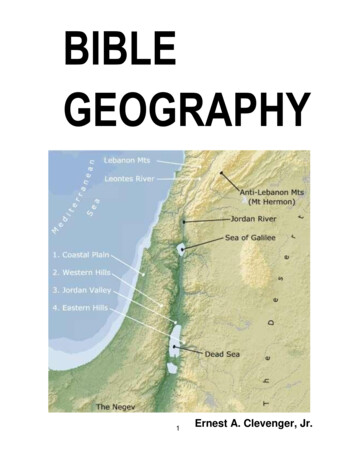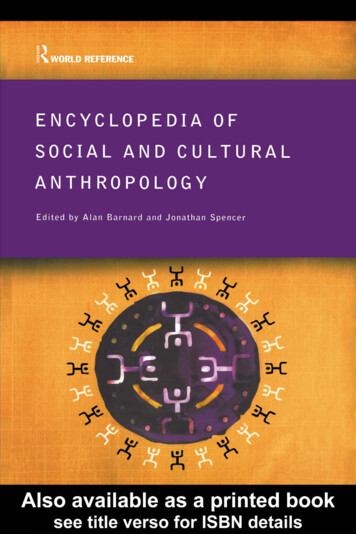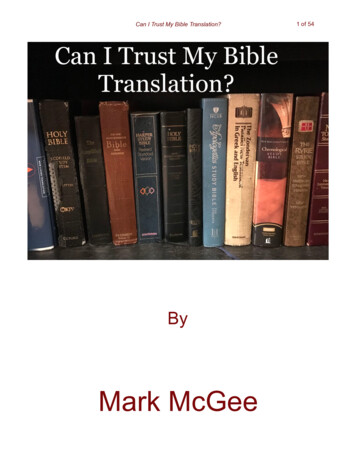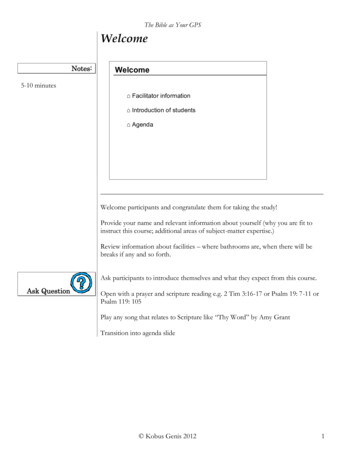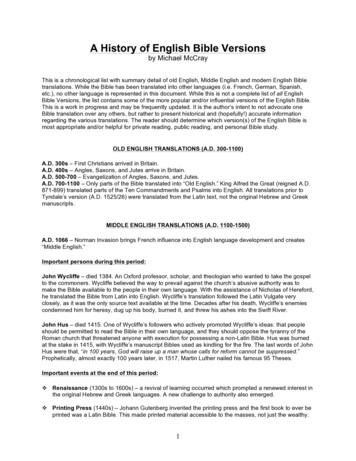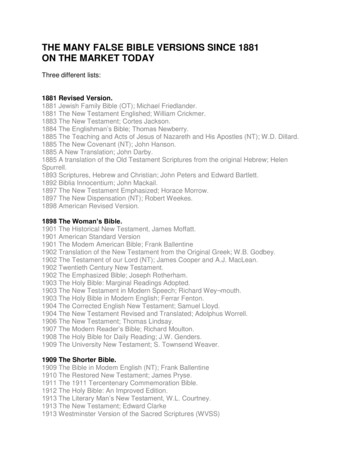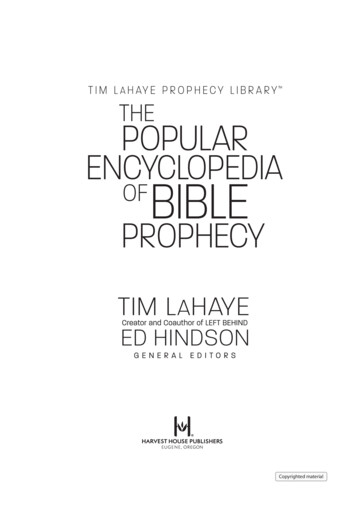
Transcription
Copyrighted materialPopular Encyclopedia of Bible Prophecy fm.bm.indd 110/30/17 4:35 PM
Copyrighted material
Verses marked nasb are taken from the New American Standard Bible , 1960, 1962, 1963, 1968, 1971, 1972, 1973,1975, 1977, 1995 by The Lockman Foundation. Used by permission. (www.Lockman.org)Verses marked nkjv are taken from the New King James Version. Copyright 1982 by Thomas Nelson, Inc. Used bypermission. All rights reserved.Verses marked kjv are taken from the King James Version of the Bible.Verses marked niv are taken from the HOLY BIBLE, NEW INTERNATIONAL VERSION . NIV . Copyright 1973, 1978, 1984 by the International Bible Society. Used by permission of Zondervan. All rights reserved.Verses marked net are taken from the New English Translation BIBLE copyright 2003 by Biblical Studies PressL.L.C. All rights reserved. Used by permission.Cover by Dugan Design Group, Bloomington, MNTIM LAHAYE PROPHECY LIBRARY is a series trademark of Tim F. LaHaye and Beverly J. LaHaye. Harvest HousePublishers, Inc., is the exclusive licensee of the trademark TIM LAHAYE PROPHECY LIBRARY.The Bible version used by the contributor of each article in this encyclopedia is cited after the first Bible quote in thearticle.THE POPULAR ENCYCLOPEDIA OF BIBLE PROPHECYCopyright 2004 by Tim LaHaye and Ed HindsonPublished by Harvest House PublishersEugene, Oregon 97408www.harvesthousepublishers.comISBN 978-0-7369-7385-4 (pbk.)ISBN 978-0-7369-7386-1 (eBook)Library of Congress Cataloging-in-Publication DataThe popular encyclopedia of Bible prophecy / Tim LaHaye and Ed Hindson, general editors; Wayne Brindle, managingeditor. p. cm.Includes bibliographical referencesISBN 0-7369-1352-1 (hardcover)1. Bible—Prophecies—End of the world—Encyclopedias. I. LaHaye, Tim F. II. Hindson, Edward E. III. Brindle, Wayne.BS649.E63P67 2004220.1'5'03—dc222004012971All rights reserved. No part of this publication may be reproduced, stored in a retrieval system, or transmitted in anyform or by any means—electronic, mechanical, digital, photocopy, recording, or any other—except for brief quotationsin printed reviews, without the prior permission of the publisher.Printed in the United States of America17 18 19 20 21 22 23 24 / LB-CF / 10 9 8 7 6 5 4 3 2 1Copyrighted materialPopular Encyclopedia of Bible Prophecy fm.bm.indd 210/31/17 9:06 AM
Encyclo/BibleProph.Final12/6/0410:50 AMPage vTOPICS70 Weeks of Daniel (see “Seventy Weeks ofDaniel”)666 (see “Six Hundred Sixty-Six”)1000 Years (see “One Thousand Years”)144,000 (see “One Hundred Forty-FourThousand”)Abomination of DesolationAbrahamic CovenantActs, Eschatology ofAges of ostasyArk of the CovenantArmageddonBabylonBeastBirth PangsBlessed HopeBook of LifeBowl JudgmentsChurch AgeChurch in ProphecyConversion of IsraelCovenantsCrownsDaniel, Eschatology ofDavidic CovenantDay of the LordDeceptionDemons and Unclean SpiritsDispensationalismDispensationsElders (24)EschatologyEternal LifeEzekiel, Eschatology ofFalse ProphetFalse ProphetsFeasts of IsraelFig TreeFinal RevoltFuture EventsFuture LifeGeneration, ThisGlorious AppearingGog and MagogGreat TribulationGreat White Throne JudgmentHeavenHebrews, Eschatology ofHellHermeneuticsHoly Spirit and EschatologyImminenceInterpretation of ProphecyIsaiah, Eschatology ofIsrael in ProphecyJames, Eschatology ofJeremiah, Eschatology ofJerusalem in ProphecyJesus ChristJews in ProphecyJohn, Eschatology ofvCopyrighted material
Encyclo/BibleProph.Final12/6/0410:50 AMPage viT HE P OPULAR E NCYCLOPEDIAJudgment of the NationsJudgment Seat of ChristJudgments of the New TestamentKingdom of GodKingdom ParablesLake of FireLamb of GodLast DaysLast TrumpetLawless OneLittle ScrollMark of the BeastMarriage of the LambMatthew, Eschatology ofMercy of GodMessianic KingdomMessianic ProphecyMidtribulationismMillennial SacrificesMillennial TempleMillennial ViewsMillenniumMysteriesNew JerusalemNumbers in ProphecyOlivet DiscourseOne Hundred Forty-Four ThousandOne Thousand YearsPartial RapturePatmosPaul, Eschatology ofPentecostPeter, Eschatology ismPreterismPretribulationismPre-wrath RaptureProgressive DispensationalismProphetic FulfillmentOFB IBLE P ROPHECYProphetic PostponementProphetsPsalms, Eschatology ofRaptureRapture, History ionsRevelation, Book ofRevelation, Date ofRewardsRoman EmpireSatanSeal JudgmentsSecond Coming of ChristSeven ChurchesSeventy Weeks of DanielSheolSigns of the TimesSix Hundred Sixty-SixSon of GodSon of ManTempleThessalonians, Eschatology ofThrone of DavidThrone of GodTimes of the GentilesTribulationTribulation Saints and MartyrsTrumpet JudgmentsTrumpet of GodTypologyVengeanceWar in HeavenWitnesses, TwoWorld EmpireWrath of GodWrath of the LambZechariah, Eschatology ofviCopyrighted material
Encyclo/BibleProph.Final12/6/0410:50 AMPage 1INTRODUCTIONin the heart of the church, it gives believers avision for world missions, and it injects adesire to live a holy life in an age of unholiness. That is why the LaHaye ProphecyLibrary was launched in conjunction withHarvest House Publishers several years ago.This Popular Encyclopedia of Bible Prophecy isa key book in the series and may in fact be oneof the most comprehensive. With the help ofDr. Wayne Brindle, we have compiled a teamof prophecy experts who have written on themost important subjects of prophetic study.They may differ slightly on minor points ofdiscussion, but they are all in agreement withthe major issues of biblical eschatology, particularly in terms of holding to the pretribulational, premillennial view of the end times.The topics covered in this encyclopedia havebeen arranged alphabetically for ease of study,and the articles have been written to appealto both those who are new to prophecy andthose who are experienced students of thesubject. We hope this volume will inspire youto search the Scriptures and become, as theapostle Paul admonished, “Approved toGod rightly dividing the word of truth”(2 Timothy 2:15).Our sincere prayer is that these articles willinform your mind, bless your heart, and stiryour soul with the blessed hope of Jesus’ coming.As our Lord Himself instructed us, we are continually watching for His imminent return tocall us home to be with Him. In the meantime,we are challenged and admonished to keepwatching, be ready, and continue serving Himuntil He comes (Matthew 24:42-46).never before has fascination with Bibleprophecy been more acute than it is today. Partof that interest is due to the uncertainty of ourtimes. Our world has become more and moremarked by political instability and contentiousstrife, particularly in the Middle East. All overthe globe, societies are characterized by thisthreat, along with our society’s decliningmorals, rampant crime, and governmentalturmoil. People living in these turbulent timeswant answers, and many are turning to theBible to get them. Despite easy access tomodern technologies and conveniences,including computers that can process billionsof bits of information in the blink of an eye,many people still believe that the Bible, abook written thousands of years ago, holds theanswers to life and the life hereafter.Unfortunately, most seekers get little helpin the area of prophetic study. Unless they takeit upon themselves to make prophecy a special study, they are not fully equipped toanswer many of the questions they may haveon this vitally important subject. And important it must be, for 28 percent of the Bible wasprophetic when it was written! Evidently Godconsidered it important to include propheticpassages in nearly every book in the Bible, andHe used, almost exclusively, prophets to recordthe Scriptures. As the apostle Peter said, “Holymen of God [the prophets] spoke as they weremoved by the Holy Spirit” (2 Peter 1:21 nkjv).The accuracy of their inspired writing, particularly the prophetic portions, proveswithout question that the Bible is of divineorigin.Nothing motivates Christians like thestudy of prophecy. It puts an evangelistic fireTim LaHayeEd Hindson1Copyrighted material
Encyclo/BibleProph.Final12/6/0410:50 AMPage 3ABOMINATION OFDESOLATIONjudgment not upon the Temple but upon theone who desecrates it (see Daniel 9:27).Daniel’s and Jesus’ use of the phrase clearlyinfluenced other prophetic scriptures (2 Thessalonians 2:3-4; Revelation 11:1-2).The New Testament uses bdelugma (theGreek word translated “abomination”) fourtimes (Luke 16:15; Revelation 7:4-5; 21:27).The Septuagint (the Greek translation of theOld Testament) uses it 17 times. It comesfrom a root term that means “to make foul”and “to stink.” Thus it refers to something thatmakes one feel nauseous, and by implication,something morally abhorrent and detestable.As with the Hebrew meaning in the Old Testament, the New Testament Greek term pointsparticularly to idols or idolatrous practices.The Greek word eremoseos (translated “desolation”) means “to lay waste, make desolate,bring to ruin” (see Matthew 12:25; Luke 11:17;Revelation 17:16; 18:17,19). The Septuagintuses it to describe the desolation of the Landas a result of desecration and exile.The phrases abomination of desolation, desolating abomination, and abomination thatmakes desolate refer to violations of the ritualpurity of the Jewish Temple in Jerusalem.They translate the Hebrew term shiqqutz(im)meshomem and the Greek term bdelugma teseremoseos, and they appear in prophecies aboutthe desecration and defilement of the Templein both a.d. 70 and at the end of the age.OLD TESTAMENT TERMSIn the Old Testament, the phrase occursonly in Daniel (9:27; 11:31; 12:11). It conveysthe feeling of horror that God’s people feelwhen they witness criminal and barbaric actsof idolatry. These acts rendered the Temple ritually unfit for the worship and service of God.Daniel laments the foreign domination ofJerusalem and desolation of the Temple: “Howlong will the vision about the regular sacrificeapply, while the transgression causes horror,so as to allow both the holy place and the hostto be trampled?” (Daniel 8:13 nasb). In Daniel12:11 we read of a foreign invader abolishingthe regular sacrifice and substituting “anabomination of desolation.” The word “abomination” shows how appalled Daniel is at theforcible intrusion of idolatry into a place ofsanctity in order to cause defilement.THEOLOGICAL MEANINGIn both Hebrew and Greek, the phrasethe abomination of desolation is an unusualgrammatical construction. The best explanation for this is the literary and theologicallinkage of abomination and desolation in theprophetic writings of Jeremiah and Ezekiel.These texts treat extensively the desecrationand defilement of the Temple, and they frequently mention the abominations and desolations of pagan profanation of the Sanctuary(Jeremiah 4:1,27; 7:10; 44:22; Ezekiel 5:11,1415; 7:20) as well as the foreign invaders whowill further desecrate and destroy the Temple(Jeremiah 4:6-8; Ezekiel 6:11; 7:20-23). Jeremiah 44:22 in particular states that Israel’sabominations have caused the desolation ofthe Land and made it “an object of horror”(compare Ezekiel 5:11,15; 7:20-24; 36:19-21).This brief survey shows that the Israelitesconsidered acts of ritual impurity and especially of foreign invasion of the Temple asultimate violations of sanctity and as a sign ofjudgment. The Jews were extremely careful toNEW TESTAMENT TERMSIn the New Testament, the phrase appearsonly in the Olivet Discourse (Matthew 24:15;Mark 13:14), where Jesus has Daniel’s prophecyin mind. The term eremos (“desolation”) doesappear in Luke 21:20, but it does not refer tothe technical phrase and describes the condition of Jerusalem in general, not the Templein particular. Jesus uses the same word inMatthew 23:38, and even though He is referring to the Second Temple, He is predictingits destruction (rather than its desecration) andGod’s judgment upon it. This is quite distinctfrom the desecration caused by the abomination of desolation, which results in divine3Copyrighted material
Encyclo/BibleProph.Final12/6/04410:50 AMA BOMINATIONprevent such acts and even built a protectivefence around the Second Temple. It includeda warning inscription promising death to anynon-Israelite who passed beyond it into thecourt of the Israelites. The New Testament(Acts 21:27-28) records the violent oppositionof a Jewish crowd who believed Paul hadtaken a Gentile proselyte (Trophimus) into theTemple to offer sacrifice. They accused Paulof “defiling the holy place” (the Temple). Withthis background, we can understand why thefuture act of desecration by the abominationof desolation is the climax of Daniel’s seventieth week and signals the intensification ofGod’s wrath in the second half of the Tribulation (Matthew 24:15-21; Mark 13:14-19).HISTORICAL BACKGROUNDDuring the construction of the SecondTemple, a host of actual and would-be desecrators of the Temple invaded Jerusalem.However, Daniel appears to be predicting theinvasion of the Syrian–Greek ruler AntiochusIV Epiphanes (175–164 b.c.), who erected anidol in the Temple near the Brazen Altar. InDaniel 11:31 we read, “Forces from him willarise, desecrate the sanctuary fortress [Templecompound], and do away with the regularsacrifice. And they will set up the abomination of desolation.” This occurred in 167 b.c.In response, the Jewish priests revolted andrededicated the Temple (an event commemorated as the Feast of the Dedication in John10:22-23), leading to a Jewish military overthrow of Antiochus’ forces.Some critical scholars have dismissed aneschatological interpretation of the abomination of desolation in Daniel, assuming allreferences must refer to Antiochus’ desecrationand claiming Daniel was written after thisevent. However, Jesus understood that thehistorical application of the phrase to Antiochus’ desecration was a pattern of the ultimate eschatological event—the abominationof the Antichrist. Citing Daniel’s prophecy(some 200 years after Antiochus’ desecration)and referring to the still-future abominationof desolation (Matthew 24:15; Mark 13:14),OFPage 4D ESOLATIONJesus affirmed both His and Daniel’s awareness of the eschatological application of thephrase.PROPHETIC IMPLICATIONSJesus saw His message as a continuation ofthe biblical prophets and evaluated His generation in the light of them. He frequentlycited Jeremiah and Zechariah and appliedthese prophecies to the soon-coming judgment of Jerusalem in a.d. 70 as well as themore distant final judgment. For example, atthe “cleansing of the Temple,” Jesus quotedboth Jeremiah 7 (which referred the threat ofritual defilement to the Temple followingJeremiah’s Temple sermon) and texts in Isaiahand Zechariah (which referred to the Temple’sfuture state). Jesus’ Olivet Discourse also setsthe Temple in an eschatological context.When the disciples heard Jesus’ prediction ofthe Second Temple’s destruction (Matthew24:1-2; Mark 13:1-2; Luke 21:5-6), they apparently connected it to the messianic advent atthe end of the age and asked for a sign(Matthew 24:3; Mark 13:4; Luke 21:7; see also1 Corinthians 1:22). The “sign” He gave themwas that of Daniel’s abomination of desolation (Matthew 24:15; Mark 13:14). This, then,was the sign that the Jewish nation was nearingthe time of messianic deliverance and restoration, for the desecration of the Temple wouldbegin the persecution of the Jewish people(that is, the “great Tribulation,” Matthew24:16-22; Mark 13:14b-20). Only the MessiahHimself will be able to bring them redemption from their enemies (Matthew 24:30-31;Mark 13:26-27; Luke 21:28).Luke’s account does not include the abomination of desolation in the Temple because thisis an eschatological event, and he has selectivelyfocused on the immediate concern of the disciples (note the phrase “about to take place”in Luke 21:7) concerning when the predicteddestruction of the Temple (and Jerusalem)would occur. For this reason he also omits theend-time persecution of the Tribulation(Greek, thlipsis), which is connected with thisevent, substituting the term “great distress”Copyrighted material
Encyclo/BibleProph.Final12/6/0410:50 AMA BOMINATION(Greek, anagke), which better describes thelocal invasion and trampling of the city (Luke21:23-24), fulfilled in the Roman conquest ofJerusalem in a.d. 70.Matthew and Mark place the abominationof desolation in the time when “the end willcome” (Matthew 24:14). It separates the periodof “tribulations” or “birth pangs” (Matthew24:6-12; Mark 13:7-9) from the “great tribulation” period (Matthew 24:21; Mark 13:19).Luke does this in Luke 21:24 by separating theevent of Jerusalem’s desolation (a.d. 70) andthe times of the Gentiles (present age) fromthe time when “the times of the Gentiles arefulfilled.”The abomination of desolation marks themidpoint of Daniel’s seventieth week, dividingthe Tribulation into two divisions of lesserand greater intensity (Daniel 9:27). This corresponds to the “42 months” of Revelation11:1-2 and the 1290 days of Daniel 12:11.Preterists interpret the abomination of desolation (as they do most prophetic events) ashaving its ultimate fulfillment in the destruction of the Temple in a.d. 70. However, theevents of the First Revolt that culminatedwith the destruction of a.d. 70 do not matchthe details in the “abomination of desolation”texts. None of the incursions by Roman officials during this time could be regarded asabominations that caused desolation becausethey did not affect the sacrificial system. Foreigners in the Temple may desecrate theTemple without defiling it. That is why theJews could rebuild the Temple after its desecration and destruction by the Babylonianswithout the need of a purification ceremony(Ezra 3:2-13). Further, the entrance of theRoman general Titus (who destroyed theTemple) occurred only after the Sanctuarywas already in flames and had been largelyruined and after the Jewish sacrifices hadceased. This is important to note since theabomination of desolation of which Danielspeaks, and to which Jesus refers, speaks onlyof the cessation of sacrifice in the Temple,not of the Temple’s destruction.Page 5OFD ESOLATION5ESCHATOLOGICAL FOCUSAny interpretation except the eschatological leaves us with unresolved details that wemust either interpret in a nonliteral, nonhistorical manner, or dismiss altogether. Theeschatological view also explains the meaningof types that await their anti-type for ultimatefulfillment. Moreover, Daniel’s seventiethweek, and especially its signal event of theabomination of desolation, influenced the literary structure of the Olivet Discourse and thejudgment section of the book of Revelation(chapters 6–19). Jesus’ interpretation of theorder of the events of the seventieth week inthe context of prophetic history appears toconfirm an eschatological interpretation forDaniel 9:27. Matthew 24:7-14 predicts thatpersecution, suffering, and wars will continueto the end of the age, climaxing in a time ofunparalleled distress (verses 21-22). This corresponds to “the time of Jacob’s distress”(Daniel 12:1; Jeremiah 30:7). Only after theseevents does Jesus make reference to Daniel 9:27(verse 15) concerning the signal event of thistime of Tribulation. If the seventy sevens (kjv,“weeks”) were to run sequentially, withoutinterruption, then why does Jesus place thisintervening period before the fulfillment ofthe events of the seventieth week? The text ofMatthew in particular shows that Jesus wasanswering His disciples’ questions concerningHis second coming and the end of the age(Matthew 24:3). Jesus here explains that Hiscoming is necessary for divine intervention andnational repentance (verses 27-31; Zechariah12:9-10) and will occur “after the tribulationof those days” (Matthew 24:29). According toMatthew, the events described in this periodprior to the messianic advent could not havebeen fulfilled in a.d. 70 with the destructionof Jerusalem because these events usher inand terminate with the coming of Messiah.Although the phrase abomination of desolation does not appear in Paul’s description ofthe end-time desecration of the Temple in2 Thessalonians 2:4, he obviously has this eventin view. For example, the Septuagint sometimes uses both bdelugma (“abomination”) andCopyrighted material
Encyclo/BibleProph.Final612/6/0410:50 AMA BOMINATIONanomia (“lawlessness”) to refer to idolatrouspractices. Thus in 2 Thessalonians 2:3-4, Pauldescribes the figure who magnifies himselfabove every idol as “the man of lawlessness.”In fact, Paul’s explanation of this event servesas a commentary on both Daniel’s “abomination of desolation” texts (particularly Daniel9:27) and Jesus’ statement of it as a “sign” inthe Olivet Discourse. Moreover, Paul uses theevent to answer the same time-related questionof the end time that Jesus’ disciples asked.This further affirms the eschatological interpretation of the abomination of desolation.Paul wrote to the Thessalonian church toadmonish Christians who had abandoned thenormal affairs of life. They believed the imminent coming of Christ that Paul had previouslyespoused (1 Thessalonians 4:13-18) was alreadyset in motion (2 Thessalonians 2:2). Paulexplained that before the “appearance” of theMessiah, the Antichrist must first appear (verses3-9). The signal event that will manifest theAntichrist, whom this text refers to as “theman of lawlessness,” “the son of destruction”(verse 3b), and “that lawless one” (verse 8), ishis usurpation of God’s place in the Temple(verse 4; see also Exodus 25:8). This act willreveal not only the Antichrist but also “the lie”(the deification of the Antichrist, Revelation13:4-6,15) that will mark his followers (Revelation 13:16-18) and confirm them in the eschatological judgment that will occur at thecoming of the Lord (2 Thessalonians 2:8-12).ABOMINATION OF THE ANTICHRISTPaul introduces the desecration of theTemple in 2 Thessalonians 2:4 by saying thatthe man of lawlessness “exalts himself.” He elevates himself “over every so-called god orobject of worship.” While this might indicatea superlative blasphemy of God such as inRevelation 13:6, the immediate setting is thefuture (rebuilt) Jerusalem Temple, and so the“objects of worship” are sacred vessels (see2 Chronicles 5:5-7; Hebrews 9:2-5) and the“desolation” occurs within the innermostsacred part of the Temple (the Holy of Holies),where God’s presence was previously mani-OFPage 6D ESOLATIONfested (Exodus 25:22; 30:6; see also Ezekiel43:1-7).The abomination, however, is the Antichrist’s act of enthroning himself in the placeof deity to “display himself ” (Greek, apodeiknunta) as God (literally, “that he is God”). Thisblasphemous act fulfills Daniel’s predictionthat the Antichrist “will exalt and magnifyhimself above every god and will speak monstrous things against the God of gods” (Daniel11:36). With the satanic background of Revelation 12:9,12-17; 13:4-10, the abominationhas allusions to Isaiah 14:13-14 and Ezekiel28:2-9, where the usurping figures “raise [their]throne above the stars of God,” “make [themselves] like the Most High,” and declare, “I amgod; I sit in the seat of the gods.”Despite the precedent of the literal interpretation of the Olivet Discourse, whichclearly refers to the desecration of the historicJewish Temple in Jerusalem, some interpret2 Thessalonians 2:4 in a nonliteral manner,taking “the temple of God” metaphorically asa reference to the church. They view the actof desecration by the “man of lawlessness” asapostasy in the church. However, writing toa first-century audience at a time when theSecond Temple was still standing, Paul’s reference to “the temple of God” could onlymean one place—the Jewish Temple in Jerusalem.We also have other reasons for rejecting thesymbolic interpretation and applying theprophecy to a literal Temple (and therefore aliteral abomination of desolation): (1) In thefew places where Paul used the Greek wordnaos (“temple”) to mean something other thanthe actual Holy Place at Jerusalem (1 Corinthians 3:16; 6:19; 2 Corinthians 6:16; Ephesians2:21), he always explained his special meaningso that his readers would understand hismetaphorical usage. (2) The word “temple” in2 Thessalonians 2:4 has the definite article(“the temple”) in contrast to Paul’s metaphorical usage, where “temple” is usuallyanarthrous (“a temple).” (3) “In the temple ofGod” modifies the verb “takes his seat” (Greek,kathisai), a verb suggesting a definite locality,Copyrighted material
Encyclo/BibleProph.Final12/6/0410:50 AMPage 7A BRAHAMIC C OVENANTnot an institution (such as the church). IfPaul were referring to apostasy in the church,he would better have expressed this with a verbfor “enthronement” or “usurpation” ratherthan a verb that referred to the literal act of“taking a seat.”The ante-Nicene church fathers affirmedthe literal understanding of this passage. Forexample, Irenaeus (a.d. 185) wrote: “But whenthis Antichrist shall have devastated all thingsin this world, he will reign for three years andsix months, and sit in the Temple at Jerusalem; and then the Lord will come fromheaven in the clouds, in the glory of the Father,sending this man and those who follow himinto the lake of fire; but bringing in for therighteous the times of the kingdom.” Irenaeus’ literal interpretation of the Temple’sdesecration is both eschatological and premillennial. By contrast, the symbolic or “spiritual” use of “temple” for the church does notappear in developed form until the third century a.d. with Origen, who was influenced bythe allegorical interpretations of the Hellenistic idealist school of Philo.Consequently, the eschatological interpretation of the abomination of desolation hasboth textual support and the witness of earlychurch apologists. It warns us of the future dayof deception and desolation at the midpointof the Tribulation, which will call for divinejudgment climaxing in the return of the Lord.—Randall PriceBIBLIOGRAPHYDodd, C.H. “The Fall of Jerusalem and the Abominationof Desolation.” Journal of Roman Studies 37 (1947),pp. 51-63.Ford, Desmond. The Abomination of Desolation in Biblical Eschatology. Washington, DC: University Press ofAmerica, 1979.Price, Randall. The Desecration and Restoration of theTemple in the Old Testament, Jewish Apocalyptic Literature, and the New Testament. Ann Arbor, MI: UMI,1993.Wenham, David. “Abomination of Desolation.” In AnchorBible Dictionary. New York: Doubleday, 1992.Zmijewski, J. “Bdelugma.” In Exegetical Dictionary of theNew Testament. Edited by Horst Balz and GerhardSchneider. Grand Rapids: Eerdmans Publishing Company, 1978.7ABRAHAMIC COVENANTThe fountainhead of Bible prophecy beginswith the Abrahamic covenant (Genesis 12:13,7; 13:14-17; 15:1-21; 17:1-21; 22:15-18). Thisagreement is the “mother of all redemptivecovenants,” and God’s blessings springingforth from it extend to all mankind throughout the ages.AN UNCONDITIONAL COVENANTThe Abrahamic covenant is an unconditional agreement or pact in which God revealsHis sovereign election of Abraham and hisdescendants and declares His decrees for them.Arnold Fruchtenbaum (p. 570) explains, “Anunconditional covenant can be defined as asovereign act of God whereby God unconditionally obligates Himself to bring to passdefinite promises, blessings, and conditions forthe covenanted people. It is a unilateralcovenant. This type of covenant is characterized by the formula ‘I will’ which declaresGod’s determination to do exactly as Hepromised.”The covenant or treaty formats commonlyused in the second millennium b.c. highlightthe unconditional nature of the Abrahamiccovenant. The Bible contains three kinds ofcovenants: (1) the royal grant treaty, (2) thesuzerain–vassal treaty, and (3) the parity treaty.The royal grant treaty is an unconditional,promissory covenant based on a king’s desireto reward a loyal servant. Examples includethe Abrahamic covenant (Genesis 12:1-3; 15),the Davidic covenant (2 Samuel 7:8-17), andthe Land of Israel covenant (Deuteronomy30:1-10).God confirmed and sealed the Abrahamiccovenant in Genesis 15 through a unique procedure whereby He put Abram into a deepsleep and bound Himself to keep the covenantregardless of Abraham’s response. Since Godis the only one who swore to keep thecovenant, it is clearly an unconditionalcovenant, based solely on God. Thus, we canbe absolutely confident that He will keep itCopyrighted material
Encyclo/BibleProph.Final812/6/0410:50 AMPage 8A BRAHAMIC C OVENANTand bring to pass in history every stipulationof the agreement.Comparing the Abrahamic covenant withparallel expressions in the ancient Near Eastshows that it is a royal grant treaty. Genesis 26:5(nasb) says, “Abraham obeyed me and kept Mycharge, My commandments, My statutes andMy laws.” The term “law” is from the Hebrewtorah, which basically means “to direct, teach,or instruct.” The first verb of Genesis 26:5 is“obeyed,” referring to Abraham’s obedienceto sacrifice Isaac (Genesis 22:1-2). This is similar to terminology found at Amarna incovenant contexts. The second verb is “kept,”paralleling an Assyrian grant in which Ashurbanipal rewarded his servant Bulta with a grantbecause he “kept the charge of my kingship.”Both of these verbs indicate a personal relationship rather than a legal code of ethics.Thus, obedience to torah flows from a covenantrelationship with God.Abraham’s obedience was not based onlegalistic compulsion but rather expressed hisfaithfulness to God. “A close examination ofthe context reveals no covenant stipulationswhich could be viewed as pure legislative orethical codes. What the context does reveal isthat God has praised His servant Abrahambecause he has been faithful to do whateverthe Lord instructed him to do. He did it notout of compulsion to legislation, but in afaith response to the instruction of God”(Dean, p. 13).Royal grant treaties or covenants wereunconditional. This point is important forBible prophecy because they emphasize thatGod is obligated to fulfil
Verses marked kjv are taken from the King James Version of the Bible. . This Popular Encyclopedia of Bible Prophecy is a key book in the series and may in fact be one of the most comprehensive. Wi

